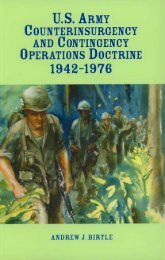C. Wiebes - Intelligence en de oorlog in Bosnië 1992-1995. De rol van de inlichtingen- en veiligheidsdiensten - Engels
C. Wiebes - Intelligence en de oorlog in Bosnië 1992-1995. De rol van de inlichtingen- en veiligheidsdiensten - Engels
C. Wiebes - Intelligence en de oorlog in Bosnië 1992-1995. De rol van de inlichtingen- en veiligheidsdiensten - Engels
- No tags were found...
You also want an ePaper? Increase the reach of your titles
YUMPU automatically turns print PDFs into web optimized ePapers that Google loves.
264as ABiH headquarters <strong>in</strong> Sarajevo and the s<strong>en</strong>ior politicians. The Bosnian national security service <strong>in</strong>Okresanica probably reported only to the Bosnian political lea<strong>de</strong>rs. 1391The question that now needs to be answered is: what was possible regard<strong>in</strong>g the process<strong>in</strong>g ofthe <strong>in</strong>tercepts <strong>in</strong> real time? Simple arithmetic shows that, if the number of channels multiplied by th<strong>en</strong>umber of required personnel is greater than the number of available personnel, th<strong>en</strong> near-real-timeprocess<strong>in</strong>g and report<strong>in</strong>g is impossible. A conservative estimate <strong>in</strong>dicates that the monitored channelsprobably covered telephone calls from Okresanica via live <strong>in</strong>terception or relayed <strong>in</strong>tercepts. Inaddition to non-military traffic, the Bosnian national security service was bound to have be<strong>en</strong> <strong>in</strong>terested<strong>in</strong> the VRS high command and the operational levels immediately below. If we assume on the basis ofthis estimate that an absolute m<strong>in</strong>imum of t<strong>en</strong> channels had to be monitored cont<strong>in</strong>uously, that threepersons were nee<strong>de</strong>d per channel for <strong>in</strong>terception, transcription and report<strong>in</strong>g and that there was arotation of three shifts a day and a sev<strong>en</strong>-day work<strong>in</strong>g week, th<strong>en</strong> at least 90 Sig<strong>in</strong>t operators wouldhave had to be active <strong>in</strong> Okresanica. Not to m<strong>en</strong>tion 15 or 20 staff for support, technology, security,cater<strong>in</strong>g and so on. H<strong>en</strong>ce, if there were 20 channels – probably a more realistic estimate – th<strong>en</strong> at least180 people would be nee<strong>de</strong>d. In reality, a maximum of t<strong>en</strong> people worked <strong>in</strong> Okresanica. Most of thecommunication was recor<strong>de</strong>d on tape. It seems therefore that near-real-time analysis and process<strong>in</strong>gwas unatta<strong>in</strong>able.The VHF radio traffic was <strong>in</strong>tercepted by the Electronic Warfare Units of the ABiH <strong>in</strong>Okresanica and Konjuh. We can perform some simple arithmetic on these activities as well. It appearsfrom all the <strong>de</strong>scriptions that these were standard Com<strong>in</strong>t sites where the list<strong>en</strong>er tuned <strong>in</strong> manually tothe channels that were be<strong>in</strong>g monitored. On the basis of a very conservative estimate, around 30channels would have to be manned perman<strong>en</strong>tly, <strong>in</strong>clud<strong>in</strong>g five frequ<strong>en</strong>cies at the level of highcommand, t<strong>en</strong> at operational level and t<strong>en</strong> tactical frequ<strong>en</strong>cies betwe<strong>en</strong> units <strong>in</strong> the field. Thirtyfrequ<strong>en</strong>cies are regar<strong>de</strong>d as the absolute m<strong>in</strong>imum by US Sig<strong>in</strong>t experts. The command and operationalfrequ<strong>en</strong>cies had to be monitored round-the-clock and the tactical frequ<strong>en</strong>cies 18 hours a day by threeteams, each consist<strong>in</strong>g of three list<strong>en</strong>ers, who were <strong>in</strong>dividually responsible for <strong>in</strong>terception,transcription and report<strong>in</strong>g. On the basis of this absolute m<strong>in</strong>imum, around 210 people would have hadto be work<strong>in</strong>g <strong>in</strong> Okresanica and Konjuh. The station was, moreover, not only responsible formonitor<strong>in</strong>g communications around Srebr<strong>en</strong>ica, but also the battles around Mount Vis, the northernpart of Republika Srpska and other areas. At least 400 people would have be<strong>en</strong> nee<strong>de</strong>d to follow all thistraffic. In fact, the level of personnel was no higher than tw<strong>en</strong>ty. So, near-real-time analysis wasimpossible here as well. 1392 We have already shown that the Electronic Warfare Units were also verymo<strong>de</strong>st <strong>in</strong> size.The process<strong>in</strong>g of Com<strong>in</strong>t can only be <strong>de</strong>scribed as long and laborious. With only a limitednumber of receivers at his disposal the <strong>in</strong>terceptor probably <strong>de</strong>ci<strong>de</strong>d to list<strong>en</strong> to the most valuablefrequ<strong>en</strong>cies. If the number of valuable frequ<strong>en</strong>cies was greater that the number that could be<strong>in</strong>tercepted, th<strong>en</strong> tape recor<strong>de</strong>rs were used. In addition, the <strong>in</strong>terceptor missed much of the messageswh<strong>en</strong> he had to leave his post to make his transcriptions <strong>in</strong> rough notes. Presumably, the <strong>in</strong>terceptorsp<strong>en</strong>t 25% of his work<strong>in</strong>g hours away from his receiver and missed a lot, because there was no-one torelieve him. The comman<strong>de</strong>r th<strong>en</strong> had the thankless job of ‘handl<strong>in</strong>g’ the <strong>in</strong>tercept for the third timeand typ<strong>in</strong>g it out. Probably, Okresanica did not have a direct phone l<strong>in</strong>e with Tuzla. As a result, theworked-out <strong>in</strong>tercepts had to be stored on a floppy disk and s<strong>en</strong>t by courier to the headquarters of the21 st Division or the 2 nd Corps.Accord<strong>in</strong>g to witnesses at the Tribunal, the work<strong>in</strong>g methods were exactly the same <strong>in</strong>Okresanica and Konjuh. 1393 In some cases the <strong>in</strong>tercepted calls were first recor<strong>de</strong>d on tape and th<strong>en</strong>later worked out on paper or <strong>in</strong> a logbook. The messages were th<strong>en</strong> typed out on a computer and s<strong>en</strong>t1391 Confid<strong>en</strong>tial <strong>in</strong>formation (54).1392 Confid<strong>en</strong>tial <strong>in</strong>terviews (6), (13), (54) and (62).1393 See: http://www.un.org/icty/news/krstic/krstic-cp.htm.





